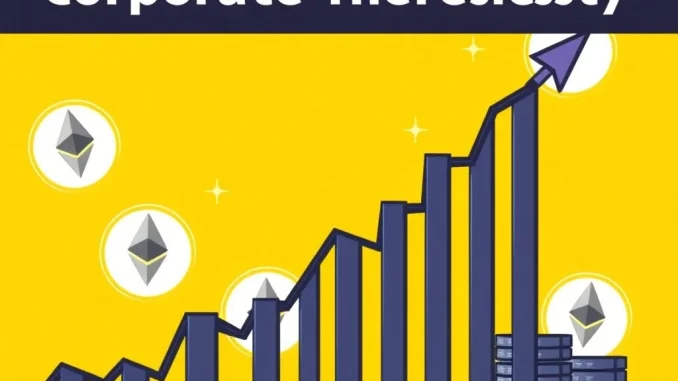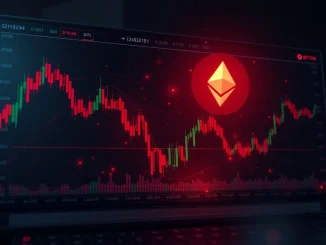
In a surprising and significant move that underscores the growing intersection of traditional finance and digital assets, Sharplink Gaming, a Nasdaq-listed company, has announced a dramatic expansion of its strategy to acquire Ethereum (ETH). This bold step involves a massive increase in its stock sale plan, earmarking billions specifically for future Ethereum purchases to bolster its corporate treasury. For anyone following the crypto market, this isn’t just a ripple; it’s a potential wave signaling deeper institutional confidence in the second-largest cryptocurrency.
Sharplink Gaming’s Strategic Pivot: Why Now?
Sharplink Gaming, a name typically associated with the gaming sector, is making headlines for its innovative approach to corporate finance. The company recently filed with the U.S. Securities and Exchange Commission (SEC) to sell an additional $5 billion in common stock. This isn’t just about raising capital; it’s explicitly aimed at funding substantial ETH acquisitions for their corporate reserves. This new filing dramatically increases their total stock sale limit under the existing sales agreement to $6 billion, combining a prior $1 billion with this new $5 billion supplement.
This move positions Sharplink Gaming as a significant player in the corporate adoption of cryptocurrencies. While Bitcoin has often been the digital asset of choice for corporate treasuries, Sharplink’s focus on Ethereum highlights a growing recognition of ETH’s unique value proposition. It signals a belief not just in the asset’s potential appreciation but also in the underlying utility and ecosystem of the Ethereum blockchain.
Understanding the ETH Accumulation Strategy
Why would a Nasdaq-listed company like Sharplink Gaming commit such substantial resources to ETH accumulation? The reasons are multifaceted and reflect a sophisticated understanding of the evolving financial landscape. Companies are increasingly looking beyond traditional fiat and low-yield bonds for their treasury reserves, seeking assets that offer both potential growth and a hedge against inflation.
- Diversification: Adding a non-correlated asset like Ethereum to a traditional treasury portfolio can reduce overall risk and enhance returns.
- Growth Potential: Ethereum, with its robust ecosystem of decentralized applications (dApps), NFTs, and DeFi, is seen by many as having significant long-term growth prospects.
- Inflation Hedge: While often associated with Bitcoin, many believe that cryptocurrencies, due to their decentralized and often deflationary nature (especially post-Merge for ETH), can serve as a hedge against fiat currency devaluation.
- Future-Proofing: Investing in foundational blockchain assets like Ethereum can position a company at the forefront of technological innovation, potentially opening doors to new business models or partnerships in the Web3 space.
This strategy is a testament to the increasing mainstream acceptance of digital assets, moving beyond speculative trading to becoming a legitimate component of corporate financial planning.
The Evolving Role of the Corporate Treasury in a Digital Age
The traditional role of a corporate treasury department is to manage a company’s financial assets, optimize liquidity, and mitigate financial risks. Historically, this has involved managing cash, short-term investments, and foreign exchange. However, the advent of cryptocurrencies is forcing a re-evaluation of these practices.
Companies like MicroStrategy have famously led the charge in adopting Bitcoin as a primary treasury reserve asset. While Sharplink Gaming is opting for Ethereum, the underlying principle is similar: using digital assets to enhance shareholder value and protect against economic uncertainties. This trend highlights several key shifts:
| Aspect | Traditional Treasury | Modern (Crypto-Inclusive) Treasury |
|---|---|---|
| Primary Assets | Fiat currency, bonds, short-term securities | Fiat, bonds, short-term securities, cryptocurrencies (BTC, ETH, etc.) |
| Risk Management | Interest rate risk, currency risk, credit risk | Above, plus crypto volatility, regulatory risk, custody risk |
| Goal | Liquidity, capital preservation, modest returns | Liquidity, capital preservation, enhanced returns, strategic positioning |
| Innovation Focus | Operational efficiency, financial optimization | Blockchain integration, Web3 opportunities, digital asset management |
For Sharplink Gaming, integrating Ethereum into its treasury strategy isn’t just about financial speculation; it’s about making a strategic bet on the future of digital infrastructure and economy.
Navigating the Stock Sale Plan: Implications and Market Reaction
The decision to fund crypto acquisitions through a significant stock sale plan has various implications. When a company issues new shares, it typically leads to dilution for existing shareholders. This means their ownership percentage in the company decreases, and potentially, their earnings per share are reduced if the company’s profits don’t grow proportionally.
However, if the market perceives the use of these funds—in this case, for Ethereum purchases—as a value-accretive strategy, the stock price might react positively in the long run. The market’s reaction will largely depend on how investors weigh the potential benefits of ETH exposure against the immediate impact of dilution and the inherent volatility of crypto assets.
The SEC filing ensures transparency and compliance, but it also puts Sharplink Gaming’s crypto strategy under public scrutiny. This transparency is crucial for investor confidence, especially when venturing into less traditional asset classes. The market will be watching closely to see how this strategy unfolds and what impact it has on Sharplink Gaming’s financial performance and valuation.
Broader Implications of Major Ethereum Purchases by Public Companies
Sharplink Gaming’s substantial Ethereum purchases are more than just a company-specific event; they carry broader implications for the entire cryptocurrency market. When a Nasdaq-listed entity commits such significant capital to ETH, it lends considerable credibility to the asset and the wider crypto space. This institutional validation can:
- Boost Market Confidence: It signals to other corporations and traditional investors that cryptocurrencies, specifically Ethereum, are maturing and becoming viable treasury assets.
- Increase Liquidity and Stability: Large-scale corporate holdings can add depth to the market, potentially reducing volatility over time as more assets are held for long-term strategic purposes rather than short-term trading.
- Pave the Way for Others: Sharplink Gaming could become a case study, encouraging other companies to explore similar strategies for their own corporate treasuries.
- Influence Regulatory Discourse: As more public companies engage with crypto, regulators may feel increased pressure to provide clearer guidelines and frameworks, fostering a more predictable environment for digital assets.
This trend suggests a future where digital assets are increasingly interwoven with mainstream corporate finance, moving from the fringes to a core component of global economic strategy.
Challenges and Considerations for Corporate Crypto Holdings
While the potential rewards are significant, companies venturing into corporate crypto holdings, especially with assets like Ethereum, face unique challenges:
- Volatility: Cryptocurrencies are known for their price swings. A sudden downturn could impact a company’s balance sheet and investor perception.
- Regulatory Uncertainty: The regulatory landscape for cryptocurrencies is still evolving. Changes in legislation or enforcement could affect the value or usability of these assets.
- Custody and Security: Safely storing large amounts of cryptocurrency requires specialized knowledge and robust security protocols to prevent hacks or loss.
- Accounting and Taxation: The accounting treatment and tax implications of crypto assets can be complex and vary by jurisdiction, requiring expert guidance.
- Public Perception: While increasingly accepted, some traditional investors might still view crypto investments with skepticism, potentially affecting a company’s stock performance.
Sharplink Gaming will need to meticulously manage these aspects to ensure its bold strategy yields the desired long-term benefits.
Conclusion: A Glimpse into the Future of Corporate Finance
Sharplink Gaming’s decision to dramatically expand its Ethereum purchases through a $5 billion stock sale plan is a powerful statement about the evolving nature of corporate finance and the increasing legitimacy of digital assets. This move highlights a growing trend where forward-thinking companies are integrating cryptocurrencies into their core financial strategies, not just as speculative plays, but as strategic reserves and potential growth drivers.
As more Nasdaq-listed companies follow suit, the lines between traditional and decentralized finance will continue to blur. Sharplink Gaming’s bold step could serve as a blueprint for others, demonstrating how corporate treasuries can strategically embrace the digital asset revolution. The coming months will be crucial in observing how this ambitious strategy impacts Sharplink Gaming and influences the broader landscape of institutional crypto adoption. This is not just about a company buying crypto; it’s about a significant shift in how corporate wealth is managed in the 21st century.



